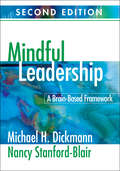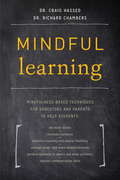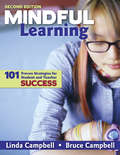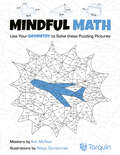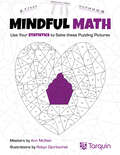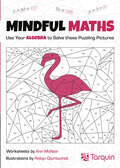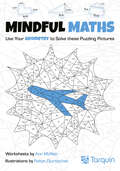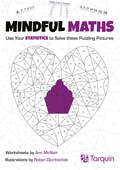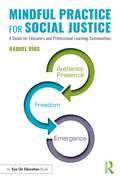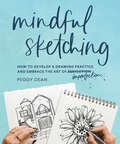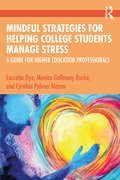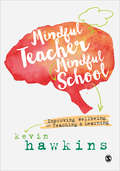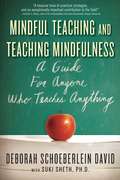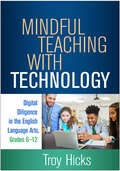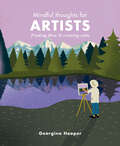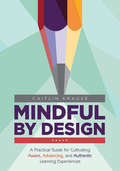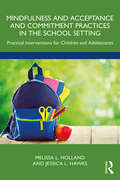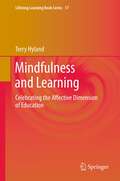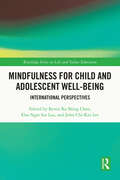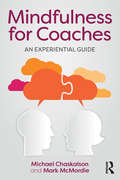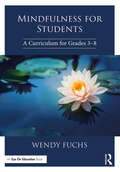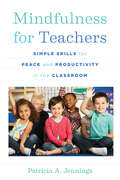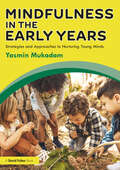- Table View
- List View
Mindful Leadership: A Brain-Based Framework
by Michael H. Dickmann Professor Nancy Stanford-BlairUnleash the power of the leadership-brain connection! Offering an approach compatible with the ways individuals naturally process information and learn, this updated edition ofConnecting Leadership to the Brain links knowledge about the physiological, social, emotional, constructive, reflective, and dispositional nature of the brain to compatible leadership practice. Leaders will find specific examples and reflection exercises focused on how to: Support the mind-body connection Promote social relationships Harness the power of emotion Expedite the construction of knowledge Build a culture of reflection Cultivate productive dispositions of mind
Mindful Learning
by Dr Richard Chambers Dr Craig HassedMindfulness-based stress reduction (MBSR), as pioneered by Jon Kabat-Zinn and others, is now being successfully applied in myriad areas of human activity--and most recently, in education. It's no surprise that psychologists and educators have found that mindfulness-based practices improve attention and performance and reduce stress in the classroom and in other school-based activities. This practical guide explains mindfulness and its applications and shows educators how it can be used with students.Topics include * cultivating resilience and managing stress * emotional development * communication and relationships * mindful use of technology * mindfulness for enhancing creativity * mindfulness and sports * teaching with attention * working with resistance * managing personal stress in the classroom * and much more This book is essential reading for teachers, counselors, parents of children high-school-age and above, and college and graduate students.
Mindful Learning: 101 Proven Strategies for Student and Teacher Success
by Linda M. Campbell Dr Bruce CampbellWith new forms, techniques, and checklists, this second edition provides 101 strategies for using learners' prior knowledge.
Mindful Math 2: Use Your Geometry to Solve These Puzzling Pictures (Mindful Math #2)
by Robyn Djuritschek Ann McNairA classic Tarquin format that has been used to teach hundreds of thousands—possibly millions—of students over the years! This book is intended to provide a restful way for students to revise and reinforce their geometry skills. On every page there are diagrams made up of small numbered areas. If that number is the answer to one of the geometry questions, then the area has to be colored. When all the target areas of a particular puzzle are colored, then the hidden picture is revealed.
Mindful Math 3: Use Your Statistics to Solve These Puzzling Pictures (Mindful Math #3)
by Robyn Djuritschek Ann McNairA classic Tarquin format that has been used to teach hundreds of thousands - possibly millions - of students over the years! This book is intended to provide a restful way for middle and high school students to revise and reinforce their statistics skills. On every page there are diagrams made up of small numbered areas. If that number is the answer to one of the statistics questions, then the area has to be colored. When all the target areas of a particular puzzle are colored, then the hidden picture is revealed.
Mindful Maths 1: Use Your Algebra to Solve These Puzzling Pictures (Mindful Maths #1)
by Robyn Djuritschek Ann McNairUK version - US version also available. A classic Tarquin format that has been used to teach hundreds of thousands - possibly millions - of students over the years! This book is intended to provide a restful way for students to revise and reinforce their algebra skills. On every page there are diagrams made up of small numbered areas. If that number is the answer to one of the algebra questions, then the area has to be coloured. When all the target areas of a particular puzzle are coloured, then the hidden picture is revealed.
Mindful Maths 2: Use Your Geometry to Solve These Puzzling Pictures (Mindful Maths #1)
by Robyn Djuritschek Ann McNairUK version - US version also available. A classic Tarquin format that has been used to teach hundreds of thousands - possibly millions - of students over the years! This book is intended to provide a restful way for students to revise and reinforce their GEOMETRY skills. On every page there are diagrams made up of small numbered areas. If that number is the answer to one of the algebra questions, then the area has to be coloured. When all the target areas of a particular puzzle are coloured, then the hidden picture is revealed.
Mindful Maths 3: Use Your Statistics to Solve These Puzzling Pictures (Mindful Maths)
by Robyn Djuritschek Ann McNairUK version - US version also available. A classic Tarquin format that has been used to teach hundreds of thousands - possibly millions - of students over the years! This book is intended to provide a restful way for students to revise and reinforce their STATISTICS skills. On every page there are diagrams made up of small numbered areas. If that number is the answer to one of the algebra questions, then the area has to be coloured. When all the target areas of a particular puzzle are coloured, then the hidden picture is revealed.
Mindful Practice for Social Justice: A Guide for Educators and Professional Learning Communities
by Raquel RíosThis book is designed to help you bring mindfulness and social justice to the forefront of your education practice, so you can work toward self-actualization and social transformation. Author Raquel Ríos offers instructional practices, coaching strategies and implementation tools to help you activate mind, body and spirit on your journey to making real changes toward equity in your school or classroom. What's Inside: Chapter 1 explains the importance of realizing one’s powers and how power increases when we discover its purpose and utility in society. Chapter 2 introduces you to the three domains of Peak Learning Experience (Personal, Social and Transpersonal) that lead to the targeted practices of Authentic Presence, Freedom and Emergence and discusses how bias can limit our ability to see the truth in people and situations. Chapters 3–5 delve into each domain, offering strategies, activities, reflection questions and application to practice tools. Chapter 6 discusses the importance of building the right team and the need to change how we recruit talent if we want to innovate our profession. With the powerful reflection tools and activities in this book, you and your teams will feel more equipped and supported on your path toward mindfulness, social justice and change in education.
Mindful Sketching: How to Develop a Drawing Practice and Embrace the Art of Imperfection
by Peggy DeanExpress your own creativity and develop a life-changing mindfulness practice in this guide to mindful sketching for all levels by bestselling author and artist Peggy Dean. • Combine the mental health benefits of mindfulness with the joy of sketching with this how-to guidebook by beloved art teacher Peggy Dean that walks you through the basics of staying present while you draw—and teaches you how to enjoy your work without self-criticism. • Peggy leads readers through the basics of why and how to begin mindful sketching with instruction on materials, techniques, and working with different subject matter and locations; plus offers step-by-step exercises to guide you through the learning process, and fun sketching prompts. • Learn how to stay in the moment while you're working, draw what you see around you, and embrace the results. Enjoy the mental state of calmness, flow, and non-judgmental self-expression that is mindfulness. • Great for fans of Samantha Dion Baker, James Richards, Jen Russell-Smith, Mark Kistler, Flora Waycott, Danny Gregory, and Marc Taro Holmes. Grab your sketchbook and get started—yes, you can draw!
Mindful Strategies for Helping College Students Manage Stress: A Guide for Higher Education Professionals
by Monica Galloway Burke Lacretia Dye Cynthia Palmer MasonThis practical resource offers a much-needed introduction to the why, what, and how of supporting college students through mindfulness and stress-releasing strategies. Higher education professionals are in a unique position to support, coach, and teach strategies with students to manage anxiety and emotional distress and improve well-being. Drawing on experience from the disciplines of Mental Health, Counseling, and Student Affairs, the authors provide evidence-based practices and tangible techniques supported by the latest brain-based research and neuroscience. Full of tools that college students can use daily to assist with their relaxation, meditation, focus, and stress management, this book helps higher education professionals who are not trained mental health practitioners to effectively and confidently incorporate activities to support the whole student.
Mindful Teacher, Mindful School: Improving Wellbeing in Teaching and Learning
by Kevin Hawkins"This is a book clearly written by an educator who knows mindfulness in schools from the inside. The strongest evidence for this is that Hawkins never gets carried away. He recognises that mindfulness is not a panacea, that to implement it successfully in schools is a slow and steady process, and that above all it must begin with the teachers themselves. But Hawkins also recognises how transformative mindfulness can be, having experienced it so profoundly himself as an educator in many different contexts. His anecdotes give it plenty of colour (my favourite is ‘Billy and the Mosquito’), whilst the practical guidance – Chapter 7 on implementation for example – makes it of tremendous practical value." - Richard Burnett, Co-founder and Director, Mindfulness in Schools Project (MiSP) Former school teacher turned mindfulness consultant Kevin Hawkins truly understands the joys of teaching and the desire to make a real difference in the lives of students, as well as the challenges and risks of burnout that most teachers experience on a daily basis. With this guide to mindful practice, teachers new and experienced can learn how to use mindfulness in their own professional and personal lives as well as how to incorporate it in their teaching to support student wellbeing. Combining theory with practice and illustrated with real life stories, this guide will show readers: what mindfulness is the research and scientific evidence behind it how changing the way you approach situations can transform the way you feel how to manage stress, and look after yourself how teaching mindfully can help your students what mindfulness can do for the culture in your school Packed full of DIY exercises, activities to use in the classroom and links to resources and further reading, this inspiring book will support experienced and new teachers to maintain a healthy work-life balance and thrive as a teaching professional. FOR EVEN MORE FROM KEVIN: Take a look at A Little Guide to Mindfulness - a free eBook we created with Kevin for teachers and trainees. And don't miss out on his two must-read blogs How Well Are We? An Education System Under Stress and Exam time...take a breath! Effective Affective Skills in Action
Mindful Teacher, Mindful School: Improving Wellbeing in Teaching and Learning
by Kevin Hawkins"This is a book clearly written by an educator who knows mindfulness in schools from the inside. The strongest evidence for this is that Hawkins never gets carried away. He recognises that mindfulness is not a panacea, that to implement it successfully in schools is a slow and steady process, and that above all it must begin with the teachers themselves. But Hawkins also recognises how transformative mindfulness can be, having experienced it so profoundly himself as an educator in many different contexts. His anecdotes give it plenty of colour (my favourite is ‘Billy and the Mosquito’), whilst the practical guidance – Chapter 7 on implementation for example – makes it of tremendous practical value." - Richard Burnett, Co-founder and Director, Mindfulness in Schools Project (MiSP) Former school teacher turned mindfulness consultant Kevin Hawkins truly understands the joys of teaching and the desire to make a real difference in the lives of students, as well as the challenges and risks of burnout that most teachers experience on a daily basis. With this guide to mindful practice, teachers new and experienced can learn how to use mindfulness in their own professional and personal lives as well as how to incorporate it in their teaching to support student wellbeing. Combining theory with practice and illustrated with real life stories, this guide will show readers: what mindfulness is the research and scientific evidence behind it how changing the way you approach situations can transform the way you feel how to manage stress, and look after yourself how teaching mindfully can help your students what mindfulness can do for the culture in your school Packed full of DIY exercises, activities to use in the classroom and links to resources and further reading, this inspiring book will support experienced and new teachers to maintain a healthy work-life balance and thrive as a teaching professional. FOR EVEN MORE FROM KEVIN: Take a look at A Little Guide to Mindfulness - a free eBook we created with Kevin for teachers and trainees. And don't miss out on his two must-read blogs How Well Are We? An Education System Under Stress and Exam time...take a breath! Effective Affective Skills in Action
Mindful Teaching and Teaching Mindfulness
by Suki Sheth Deborah SchoeberleinAuthor Deborah Schoeberlein pioneers the practical application of mindfulness in education. By showing teachers how to tune into what's happening, inside and around them, she offers fresh, straightforward approaches to training attention and generating caring both in and outside of the classroom. Mindful Teaching and Teaching Mindfulness emphasizes how the teacher's personal familiarity with mindfulness plants the seed for an education infused with attention, awareness, kindness, empathy, compassion, and gratitude. The book follows a teacher from morning to night on a typical school day, at home, during the commute, and before, during, and after class. This book is perfect for teachers of all kinds: schoolteachers, religious educators, coaches, parents-anyone who teaches anything.
Mindful Teaching with Technology: Digital Diligence in the English Language Arts, Grades 6-12
by Troy HicksTechnology is integral to teaching in the English language arts, whether in-person, hybrid, or remote. In this indispensable guide, Troy Hicks shows how to teach and model "digital diligence"--an alert, intentional stance that helps both teachers and students use technology productively, ethically, and responsibly. Resources and lesson ideas are presented to build adolescents' skills for protecting online privacy, minimizing digital distraction, breaking through &“filter bubbles,&” fostering civil conversations, evaluating information on the Internet, creating meaningful digital writing, and deeply engaging with multimedia texts. Dozens of websites, apps, and other tools are reviewed, with links provided at the companion website; end-of-chapter teaching points and guiding questions facilitate learning and application.
Mindful Thoughts for Artists: Finding Flow & Creating Calm (Mindful Thoughts Ser.)
by Georgina HooperFrom connecting with community to discovering your unique way of creating, this book explores the rich rewards of making art mindfully. Art in all its beautiful forms and mediums is a powerful form of expression and meditation. In Mindful Thoughts for Artists, Georgina Hooper illustrates how the act of painting allows us to access the calm that dwells within, and acts as a powerful catalyst for pleasure, acceptance and growth. Awash with colorful splashings of art history, and peppered with the rich teachings of the Ch&’an Buddhists, this lovingly-crafted little book explores how this meditative medium helps us to embrace ourselves in all our different hues. Appealing to all artists, this curated collection of 25 reflections encourages creators to live in the moment, to observe the beauty in everything, and above all, to ensure that the creative process is driven by love and enjoyment. From focussing on the process not the product, to learning to see by slowing down and devoting time to our surroundings, this book will take you on a journey both in your art and in yourself, leading to a happier, creatively free and more mindful self!
Mindful by Design: A Practical Guide for Cultivating Aware, Advancing, and Authentic Learning Experiences (Corwin Teaching Essentials)
by Caitlin E. Krause"Mindful by Design is a guide to well-being, a practical resource, and a creative call-to-action, as Caitlin Krause helps readers to bridge the gap between prioritizing true connection and achieving it." – Leah Weiss, author of How We Work: Live Your Purpose, Reclaim Your Sanity, and Embrace the Daily Grind; Lecturer, Stanford Graduate School of Business "Krause shares valuable strategies that will help any educator, coach, manager, or learning professional bring out the best in those they serve." —Dorie Clark, adjunct professor at Duke University′s Fuqua School of Business and author, Entrepreneurial You and Stand Out "Mindful by Design is a valuable and inspiring guide, offering generous insights and practical advice for those seeking to center, strengthen, and clarify their efforts both in and outside of the classroom." —Dinty Moore, author, The Mindful Writer Take mindfulness beyond the buzzword and spark powerful learning environments! As we navigate complex changes in our professional and personal lives, Mindful by Design is a resource that provides ways to infuse meaningful connection into remote learning, so that learners, teachers, and leaders can flourish. If you′re experiencing "zoom burnout," or just looking for ways to connect more deeply and integrate SEL and mindfulness into the context of your teaching practices, this book is for you! In a busy world full of challenges and distractions, mindfulness is about increasing a sense of presence and intention in everything we do. This must-have resource explores how mindfulness can improve teaching and learning, promoting the development of future-forward skills including creativity, entrepreneurship, innovation, and communication. Readers will learn how to cultivate a personal mindfulness practice that reflects their individuality, and how to create a community of care and respect through mindfulness, inviting learners to seek more authentic interactions with the curriculum, with themselves, and with each other. Mindful by Design provides 24 detailed exercises, including step-by-step mindfulness lessons embedded into specific curriculum areas, ready to implement immediately. Filled with practical, accessible explanations and applications that are adaptive and engaging, this book demystifies mindfulness and empowers each individual to embrace a personal mindfulness practice and inspire powerful learning environments.
Mindful by Design: A Practical Guide for Cultivating Aware, Advancing, and Authentic Learning Experiences (Corwin Teaching Essentials)
by Caitlin E. Krause"Mindful by Design is a guide to well-being, a practical resource, and a creative call-to-action, as Caitlin Krause helps readers to bridge the gap between prioritizing true connection and achieving it." – Leah Weiss, author of How We Work: Live Your Purpose, Reclaim Your Sanity, and Embrace the Daily Grind; Lecturer, Stanford Graduate School of Business "Krause shares valuable strategies that will help any educator, coach, manager, or learning professional bring out the best in those they serve." —Dorie Clark, adjunct professor at Duke University′s Fuqua School of Business and author, Entrepreneurial You and Stand Out "Mindful by Design is a valuable and inspiring guide, offering generous insights and practical advice for those seeking to center, strengthen, and clarify their efforts both in and outside of the classroom." —Dinty Moore, author, The Mindful Writer Take mindfulness beyond the buzzword and spark powerful learning environments! As we navigate complex changes in our professional and personal lives, Mindful by Design is a resource that provides ways to infuse meaningful connection into remote learning, so that learners, teachers, and leaders can flourish. If you′re experiencing "zoom burnout," or just looking for ways to connect more deeply and integrate SEL and mindfulness into the context of your teaching practices, this book is for you! In a busy world full of challenges and distractions, mindfulness is about increasing a sense of presence and intention in everything we do. This must-have resource explores how mindfulness can improve teaching and learning, promoting the development of future-forward skills including creativity, entrepreneurship, innovation, and communication. Readers will learn how to cultivate a personal mindfulness practice that reflects their individuality, and how to create a community of care and respect through mindfulness, inviting learners to seek more authentic interactions with the curriculum, with themselves, and with each other. Mindful by Design provides 24 detailed exercises, including step-by-step mindfulness lessons embedded into specific curriculum areas, ready to implement immediately. Filled with practical, accessible explanations and applications that are adaptive and engaging, this book demystifies mindfulness and empowers each individual to embrace a personal mindfulness practice and inspire powerful learning environments.
Mindfulness and Acceptance and Commitment Practices in the School Setting: Practical Interventions for Children and Adolescents
by Melissa L. Holland Jessica L. HawksThis book offers specific, easy-to-implement mindfulness and acceptance and commitment therapy (ACT) tools for practitioners to use in schools at an individual, group, or classroom-wide level. With the increased focus on the emotional and behavioral health of children in the schools, there is a dearth of practical books that specifically address the use of ACT techniques in the school setting. Geared toward the practitioner and how they work with students, teachers, parents, and classrooms, this book introduces a contemporary approach to targeted intervention and discusses how these services can be provided using an MTSS model. These interventions have numerous benefits including increasing attention capacity, compassion, emotional regulation, and self-calming abilities, in addition to use as an intervention for anxiety, depression, and trauma related symptoms. Graduate students and practitioners who work with children and adolescents such as school psychologists, child and adolescent clinical psychologists, and school counselors will find this book to be a novel resource of interventions for children in grades K–12, along with tools to support parents and teachers.
Mindfulness and Learning: Celebrating the Affective Dimension of Education
by Terry HylandIn recent decades, education at all levels has been seriously impoverished by a growing obsession with standards, targets, skills and competences. According to this model, only a circumscribed range of basic cognitive skills and competences are the business of education, whose main role is to provide employability credentials for people competing for jobs in the global economy. The result is a one-dimensional, economistic and bleakly utilitarian conception of the educational task. In Mindfulness and Learning: Celebrating the Affective Dimension of Education, Terry Hyland advances the thesis that education stands in need of a rejuvenation of its affective function - the impact it has on the emotional, social, moral and personal development of learners. Drawing on the Buddhist conception of mindfulness, he advances a powerful argument for redressing this imbalance by enhancing the affective domain of learning. Mindfulness and Learning: Celebrating the Affective Dimension of Education shows how the concept and practice of 'mindfulness' - non-judgmental, present moment awareness and experience - can enrich learning at all levels. Mindfulness thus contributes to the enhanced achievement of general educational goals, and helps remedy the gross deficiency of the affective/emotional aspects of contemporary theory and practice. The author outlines a mindfulness-based affective education (MBAE) programme and shows how it might be introduced into educational provision from the early years to adult education with a view to harmonising the cognitive-affective balance across the system.
Mindfulness for Child and Adolescent Well-Being: International Perspectives (Routledge Series on Life and Values Education)
by Chan, Kevin Ka Shing Lau, Elsa Ngar Sze Lee, John Chi-KinProviding a comprehensive overview of the benefits of mindfulness for children and adolescents, this edited collection offers an in-depth exploration of research, theory, and practice from international perspectives.The book written by academics and clinicians from the East and the West, first introduces mindfulness and its roots in spirituality and psychology, and then discusses its potential for enhancing the well-being of children and adolescents. It covers a wide range of topics related to the impact of mindfulness on children and adolescents, including its effects on cognitive development, academic performance, school adjustment, emotion regulation, mental health, and social functioning. The chapters also examine how mindfulness-related concepts, such as self-compassion, can benefit children with and without special needs, as well as the importance of mindful family communication and parenting for the well-being of children and adolescents.The volume offers valuable insights to researchers, educators, and practitioners who wish to help young people cultivate mindfulness and enhance well-being. The insights will also be useful for young people and parents who want to learn about the healing power and health benefits of mindfulness.
Mindfulness for Coaches: An experiential guide
by Michael Chaskalson Mark McMordieMindfulness for Coaches accessibly presents theory and research on the benefits of mindfulness training and explores how mindfulness can feature in coaching work. Michael Chaskalson and Mark McMordie explain how coaches can use mindfulness to become more deeply attuned to themselves and to clients, and to create transformational resonance. The authors present a systematic methodology to cultivate and embody a way of being that enables growth and transformation in oneself and in others. The first book of its kind, Mindfulness for Coaches provides an experiential guide, inviting and supporting coaches to engage with the programme included, sharing new qualitative research into the potential impact of mindfulness on coaching process and outcomes, and explicitly linking mindfulness practice to global standards of coaching mastery. Presented in two parts, the book first outlines a unique eight-week programme, Mindfulness for Coaches, and goes on to clarify the links between mindfulness, coaching mastery and different coaching approaches, share insights from the fields of psychotherapy, leadership and organisation development, and provide guidance for further learning. Mindfulness for Coaches will be insightful and inspiring reading for coaches in practice and in training, coaching psychologists and academics and students of all coaching modalities.
Mindfulness for Students: A Curriculum for Grades 3-8
by Wendy FuchsWhat if you walked into your classroom to find a room full of students who were working cooperatively with one another, focusing on the day’s lesson, and able to regulate their own thoughts and feelings? Learn how to teach mindfulness strategies to your elementary and middle school students to provide a foundation for social-emotional well-being and academic engagement. Based on research and designed to complement any school setting, no matter how busy, the practices in this book will create the groundwork for a positive and productive learning environment. The curriculum covers these five key mindfulness practices: Breath awareness Body awareness Focusing on gratitude Kindness toward self and others Open awareness Each chapter includes a detailed lesson plan with suggested wording, as well as support materials (e.g., journal templates, activity sheets, and infographics). These tools, as well as audio recordings of the practices, are also available on our website as free eResources for classroom use (www.routledge.com/9781138586550).
Mindfulness for Teachers: Simple Skills for Peace and Productivity in the Classroom (The Norton Series on the Social Neuroscience of Education)
by Daniel J. Siegel Patricia A. JenningsMindful awareness practices to help teachers recognize and regulate emotional reactivity in their classrooms. Teaching is one of the most rewarding professions, but also one of the most demanding. This book offers simple, ready-to-use, and evidence-proven mindfulness techniques to help educators manage the stresses of the classroom, cultivate an exceptional learning environment, and revitalize both their teaching and their students' knowledge acquisition. Drawing on basic and applied research in the fields of neuroscience, psychology, and education, as well as the author's extensive experience as a mindfulness practitioner, teacher, and scientist, it includes exercises in mindfulness, emotional awareness, movement, listening, and more, all with real-time classroom applications.
Mindfulness in Early Years: Strategies and Approaches to Nurturing Young Minds
by Yasmin MukadamThis book is an accessible companion for all early years practitioners to explore how mindfulness can be integrated into an early years learning environment. It presents topical theory and research, giving practical advice on using mindfulness as an everyday pedagogical tool to improve the emotional wellbeing of children, families and staff members. Providing a step-by-step approach for adopting mindfulness practices, the book offers photocopiable resources, information on mindfulness techniques and opportunities for critical reflection to help create a ‘mindful early years curriculum’. Chapters follows the four pillars of Calm, Acceptance, Relational Approach and Empathy, and include: The benefits of adopting a mindful approach in the early years The importance of staff wellbeing A template mindful curriculum for practitioners to adapt and use Case studies of effective mindful practices Resources, activities and techniques to create your own mindfulness toolkit This delightful book will be a source of inspiration for early years practitioners, early years teachers and those who are interested in introducing and embedding mindfulness into early years practice.
